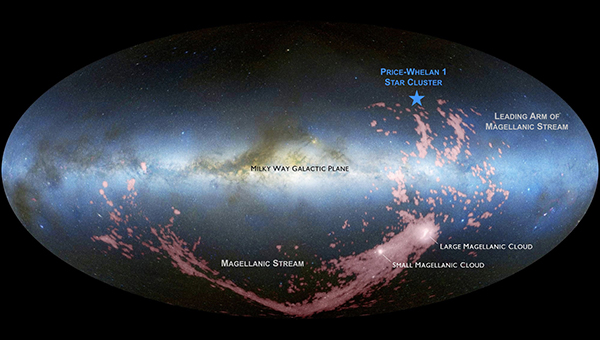Ground- and space-based observations have revealed a group of stars at the head of the giant stream of gas burrowing its way through the Milky Way.

D. Nidever / NASA
Astronomers have discovered a collection of young stars in a surprising location — deep in the halo of old stars surrounding the Milky Way.
Adrian Price-Whelan (Flatiron Institute) found the loose cluster while digging through the second data release from the European Gaia mission. Gaia is currently mapping the motions and locations of more than 1 billion stars, extending astronomers’ reach from just a few hundred light-years to most of our galaxy (see our upcoming March 2020 issue).
The newly found stars clearly move together as a set. At 116 million years old, the cluster is young and also fairly lightweight, similar to the Pleiades in both age and mass.
But unlike the Pleiades, these stars lie far away: some 94,000 light-years, roughly 200 times farther from Earth than the iconic Seven Sisters. They’re also spread out, spanning some 1,600 light-years. That means they’re probably no longer gravitationally bound together and therefore not a cluster in the technical sense of the word.
By rights, the stars shouldn’t be out there. There’s not much star-making gas in the Milky Way’s halo — the gas that is there is too hot and spread out to collapse to create new suns. What little cool stuff there is is almost entirely in the Magellanic Stream, a vast ribbon of (mostly) hydrogen gas traveling with the Large and Small Magellanic Clouds through our galaxies’ outer regions.
And the stars appear to be sailing right in front of that ribbon of gas.
A First for the Magellanic Stream
To confirm the stars’ location, Price-Whelan, David Nidever (Montana State University), and their colleagues took spectra of 28 of the brightest stars in the group. The measurements confirmed the stars’ ages and that they have fairly pristine compositions, polluted with only small quantities of heavy elements. The compositions look nothing like stellar newborns in the Milky Way, but they match the gas in the stream’s leading arm. The stars’ velocities also line up with that of the stream.
Combined, the various observations led the team to conclude these stars likely formed from the gas at the head of the Magellanic Stream, Price-Whelan and Nidever reported at the winter American Astronomical Society meeting in Honolulu. The results also appear in two papers in the Astrophysical Journal.
Murmurs of excitement from fellow astronomers greeted the team’s presentations. Observers have been looking for stars associated with the Magellanic Stream for decades, explains Jeremy Bailin (University of Alabama). Astronomers don’t know how far away the stream is, because it’s hard to determine distances to a cloud of hydrogen gas. But stars are different — and we can learn all sorts of cool things with stars.
The difficulty with distance might explain why the new cluster’s estimated distance is roughly half the number that’s often used for the Magellanic Stream. If the stream really is that much closer, it could mean that its gas — and the gas of the Magellanic Clouds — will dump into the Milky Way and spur starbirth sooner than astronomers predicted.
The stars lie in front of the stream, though, not in it. The team thinks this offset exists because, as the stream plows through the hot gas in the halo, it feels a drag. The stars don’t, however. Over time, the gas would slow down and fall behind, Nidever explained during a press conference.
Indeed, the stars’ ages match when the stream passed through our galaxy’s outer disk in the recent past. That passage could have compressed the stream’s gas, spurring starbirth.
References:
Adrian Price-Whelan et al. “Abstract 415.01: A recent star formation event far into the Milky Way halo: discovery and characterization.” 235th meeting of the American Astronomical Society.
David Nidever et al. “Abstract 415.03: A recent star formation event far into the Milky Way halo: spectroscopic follow-up and implications for the Milky Way hot halo.” 235th meeting of the American Astronomical Society.
Adrian Price-Whelan et al. “Discovery of a Disrupting Open Cluster Far into the Milky Way Halo: A Recent Star Formation Event in the Leading Arm of the Magellanic Stream?” Astrophysical Journal. December 10, 2019.
David Nidever et al. “Discovery of a Disrupting Open Cluster Far into the Milky Way Halo: A Recent Star Formation Event in the Leading Arm of the Magellanic Stream?” Astrophysical Journal. December 20, 2019.
 1
1









Comments
misha17
January 14, 2020 at 1:56 pm
"Baby stars, do-do do-do-do-do, ..."
/earworm
You must be logged in to post a comment.
You must be logged in to post a comment.